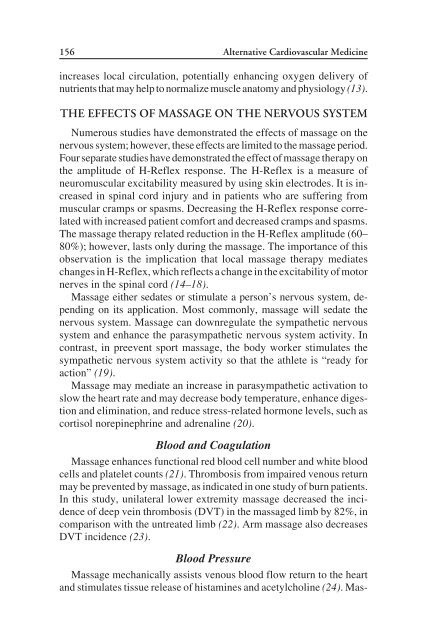Complementary Alternative Cardiovascular Medicine
Complementary Alternative Cardiovascular Medicine
Complementary Alternative Cardiovascular Medicine
You also want an ePaper? Increase the reach of your titles
YUMPU automatically turns print PDFs into web optimized ePapers that Google loves.
156 <strong>Alternative</strong> <strong>Cardiovascular</strong> <strong>Medicine</strong><br />
increases local circulation, potentially enhancing oxygen delivery of<br />
nutrients that may help to normalize muscle anatomy and physiology (13).<br />
THE EFFECTS OF MASSAGE ON THE NERVOUS SYSTEM<br />
Numerous studies have demonstrated the effects of massage on the<br />
nervous system; however, these effects are limited to the massage period.<br />
Four separate studies have demonstrated the effect of massage therapy on<br />
the amplitude of H-Reflex response. The H-Reflex is a measure of<br />
neuromuscular excitability measured by using skin electrodes. It is increased<br />
in spinal cord injury and in patients who are suffering from<br />
muscular cramps or spasms. Decreasing the H-Reflex response correlated<br />
with increased patient comfort and decreased cramps and spasms.<br />
The massage therapy related reduction in the H-Reflex amplitude (60–<br />
80%); however, lasts only during the massage. The importance of this<br />
observation is the implication that local massage therapy mediates<br />
changes in H-Reflex, which reflects a change in the excitability of motor<br />
nerves in the spinal cord (14–18).<br />
Massage either sedates or stimulate a person’s nervous system, depending<br />
on its application. Most commonly, massage will sedate the<br />
nervous system. Massage can downregulate the sympathetic nervous<br />
system and enhance the parasympathetic nervous system activity. In<br />
contrast, in preevent sport massage, the body worker stimulates the<br />
sympathetic nervous system activity so that the athlete is “ready for<br />
action” (19).<br />
Massage may mediate an increase in parasympathetic activation to<br />
slow the heart rate and may decrease body temperature, enhance digestion<br />
and elimination, and reduce stress-related hormone levels, such as<br />
cortisol norepinephrine and adrenaline (20).<br />
Blood and Coagulation<br />
Massage enhances functional red blood cell number and white blood<br />
cells and platelet counts (21). Thrombosis from impaired venous return<br />
may be prevented by massage, as indicated in one study of burn patients.<br />
In this study, unilateral lower extremity massage decreased the incidence<br />
of deep vein thrombosis (DVT) in the massaged limb by 82%, in<br />
comparison with the untreated limb (22). Arm massage also decreases<br />
DVT incidence (23).<br />
Blood Pressure<br />
Massage mechanically assists venous blood flow return to the heart<br />
and stimulates tissue release of histamines and acetylcholine (24). Mas-


